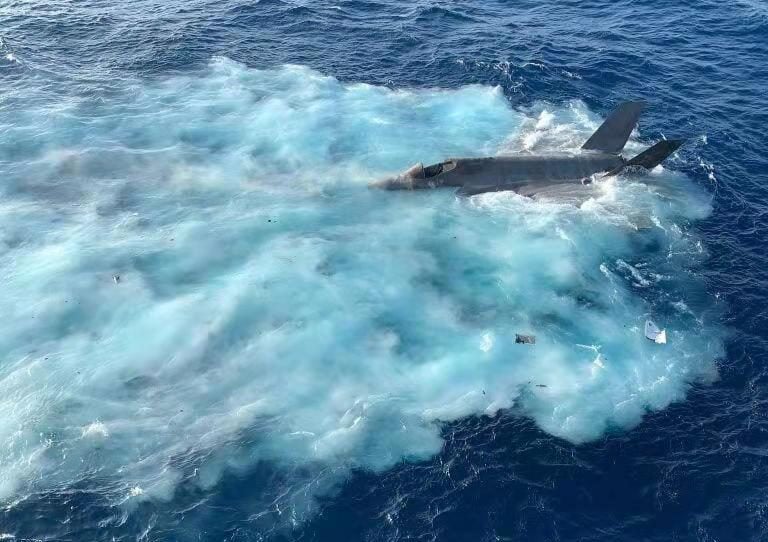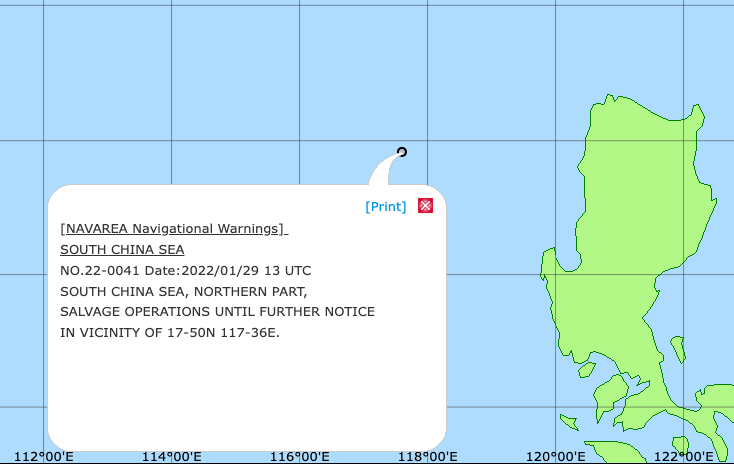
A Navy F-35C on the deck of DSCV Picasso following a March 2, 2022 recovery from 12,400 feet under the South China Sea. US Navy Photo
This post was updated with a photo from U.S.7th Fleet.
Navy salvage crews operating from a commercial salvage ship have recovered the F-35C Lightning II Joint Strike Fighter that suffered a ramp strike on the deck of USS Carl Vinson (CVN-70 and crashed into the South China Sea, a U.S. 7th Fleet spokesman confirmed to USNI News on Thursday.
The F-35C, assigned to the “Argonauts” of VFA-147 Strike Fighter Squadron (VFA), was plucked from the floor of the South China Sea with Navy personnel aboard the offshore vessel DSCV Picasso, which had departed Okinawa on Feb. 23, according to the service.
The Navy sent personnel from Task Force 75, Naval Sea Systems Command and NAVSEA’s Supervisor of Salvage and Diving aboard Picasso – a vessel designed for deep diving and salvage for offshore industries, according to owner Ultra Deep Solutions.
“The wreckage was recovered from a depth of approximately 12,400-feet by a team from CTF 75 and the NAVSEA’s Supervisor of Salvage and Diving (SUPSALV) embarked on the diving support construction vessel (DSCV) Picasso,” reads a statement from U.S. 7th Fleet.
“The aircraft was recovered using a CURV-21, a remotely operated vehicle (ROV), which attached specialized rigging and lift lines to the aircraft. The ship’s crane lifting hook was then lowered to the seafloor and connected to the rigging, and then lifted the aircraft to the surface and hoisted it onboard Picasso.”
Recovery of the aircraft eases fears that China or Russia could seize the aircraft, either to replicate the technology aboard or discover ways to defeat the fighters.
While the Navy did not specify where the recovery operations occurred, the Japan Coast Guard issued a notice to mariners in late January warning of salvage operations about 170 miles west of the Philippine island of Luzon.
The recovery of the F-35C follows a similar operation in which the United Kingdom, Italy and the United States mounted a salvage operation last year for a U.K. F-35B that crashed into the Mediterranean following a take-off from carrier HMS Queen Elizabeth (R08).
According to a video of the ramp strike that was leaked on social media, the F-35C was too low in its approach to the flight deck and struck the rear of the carrier, skidding on its belly and rotating 180 degrees while heading down the angled deck of Vinson.
The fighter slid across the deck at about 95 miles per hour before falling off the edge. The crash, which occurred on Jan. 24, injured seven sailors, including the pilot who was able to eject from the fighter before it hit the water.
The crew of Vinson was able to quickly clear the flight during a combined exercise with fighters from USS Abraham Lincoln (CVN-72). Some fighters were able to refuel on Lincoln before returning to Vinson the same day.
“One of the super rewarding …. feelings or emotions, results of the, specifically the F-35 crash, but also the…other incidents [is] the way the ship’s crew and the air wing came together and provided the perfect response,” Capt. P. Scott Miller, told USNI News on a recent embark aboard Vinson. “Our entire training track, where we do our workups with all of the training organizations back home – prepared us perfectly.”
The cause of the crash is currently under investigation.

An F-35C Lightning II Joint Strike Fighter following a crash on USS Carl Vinson CVN-70) on Jan. 24, 2022.
The following is the complete statement from U.S. 7th Fleet.
YOKOSUKA, Japan –
U.S. 7th Fleet’s Task Force (CTF) 75 and Naval Sea Systems Command (NAVSEA) successfully retrieved the F-35C Lightning II aircraft which crashed earlier this year in the South China Sea, March 2.
The F-35C Lightning II, assigned to Carrier Air Wing (CVW) 2, crashed while USS Carl Vinson (CVN 70) was conducting routine flight operations in the South China Sea on Jan. 24.
The wreckage was recovered from a depth of approximately 12,400-feet by a team from CTF 75 and the NAVSEA’s Supervisor of Salvage and Diving (SUPSALV) embarked on the diving support construction vessel (DSCV) Picasso.
“The task force’s expertise in rapid, scalable command, control, and communications, agile logistics, organic security, and explosive ordnance disposal was the most flexible choice for the fleet commander to respond in a timely manner,” said CTF 75 Commodore, Capt. Gareth Healy.
“Ultimately, this deliberate approach resulted in the correct capabilities conducting recovery operations within 37 days of the incident. Given the unique challenges of this problem and the unique technical capabilities that NAVSEA delivered, this was an aggressive and achievable timeline.”
The aircraft was recovered using a CURV-21, a remotely operated vehicle (ROV), which attached specialized rigging and lift lines to the aircraft. The ship’s crane lifting hook was then lowered to the seafloor and connected to the rigging, and then lifted the aircraft to the surface and hoisted it onboard Picasso.
The aircraft will be delivered to a nearby military installation to aid in the ongoing investigation and evaluated for potential transport to the United States.
The recovery effort shows the U.S. Navy commitment to its assets, and a free and open Indo-Pacific.
CTF 75 is 7th Fleet’s primary expeditionary task force and is responsible for the planning and execution of maritime security operations, explosive ordnance disposal, diving, engineering and construction, and underwater construction. It additionally provides direct support to diving and salvage operations and expeditionary intelligence throughout the Indo-Asia-Pacific region.
Under Commander, U. S. Pacific Fleet, 7th Fleet is the U.S. Navy’s largest forward-deployed numbered fleet, and routinely interacts and operates with 35 maritime nations in preserving a free and open Indo-Pacific region.

